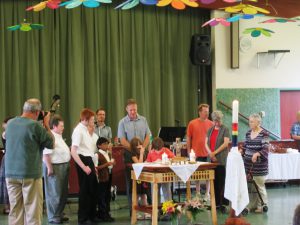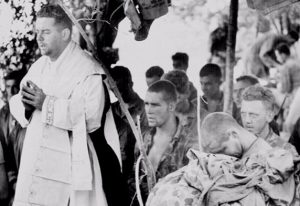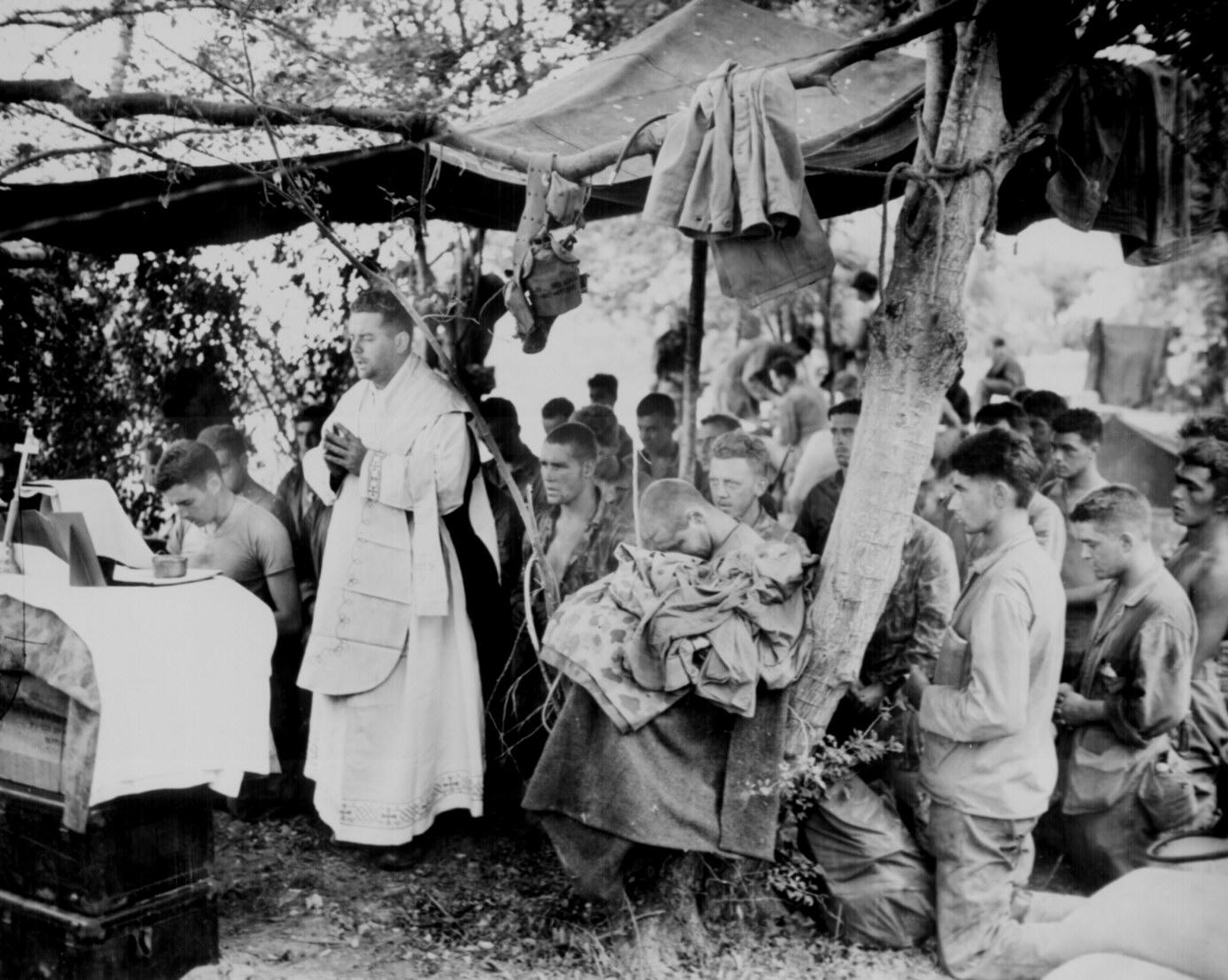I have only been a priest for seven years. About halfway through that period, I switched from the Novus Ordo to the Traditional Latin Mass and sacraments. It was also during this time that I stopped saying a line that I was famous for in seminary: “We do not have a crisis of sacraments. We have a crisis of catechesis.” I used to say this because I knew how many people received Holy Communion in this country without knowing Who they were receiving. In fact, I put my money where my mouth was: As a young priest, I taught a Eucharistic class just off-campus of Colorado State University, a school with 33,000 students. I called my class “Jesus and the Jewish Roots of the Eucharist” after this excellent book by Dr. Brandt Pitre. Most weeks I had about 50 CSU students attending that class. Their hunger and faithfulness was my proof that “we do not have a crisis of sacraments but a crisis of catechesis.” And the students responded with fervor and a greater Eucharistic love.
Programs like Catholic Formed now flood the American parishes of younger priests and more orthodox older pastors. Formed is a new video program of catechesis designed to invite the ordinary Sunday Catholic into a deeper formation of video catechesis. These movies include good information on the sacraments, moral teaching, salvation history and Catholic Church history. Formed features the common lineup of orthodox lay Catholic celebrities who have gained their fame in apologetics and chastity topics. They really do a good job at tackling our current crisis of catechesis. But do we really have a crisis of catechesis instead of the sacraments as I had said for most of my priesthood?
Since switching to the Traditional Latin Mass, I have seen that most of our modern catechetical methods are geared exclusively towards the intellect. For example, the average rich, suburban American parish now has a small handful of devoted Catholics who would not have believed in the True Presence of Christ in the Eucharist had they not read a Scott Hahn book. And God bless Scott Hahn for his great intellectual work.
But notice that in the previous paragraph I purposely used the word “rich, suburban parish.” By and large, these are the decent parishes which (thankfully!) have moved past the 1970s catechesis of exclusively-social-justice materials. Formed and That Man is You and Scott Hahn “book clubs” are all great for budding intellectuals who don’t have to work 80 hours a week on a Louisiana oil barge. But what happens to the run-of-the-mill poor Catholic? How does the blue collar worker (who might be too busy to read a book by Tim Staples) receive catechesis on the sacraments?
The answer is that for thousands of years, the catechesis happened by kneeling at Holy Mass. I do not mean that Mass is enough to catechize ourselves. I mean that the serious Catholic learned and prayed during the week as best he could. Then on Sunday, everything he learned or offered was forged in a mysterious and powerful ritual that incorporated all his senses, his intellect, his will. He would have have to kneel for most of the Mass. There was no question in his mind that he had to be “set apart” in baptism and grace to do something as strange as receive Holy Communion, even in poor mission countries of the illiterate. He might wonder: Why did he have to kneel at an altar rail? He stuck his tongue out while the priest blessed him with the Son of God. If not a sign of the majesty of God…if not a sign of the chasm between Creator and creature…this ritual was simply too weird for a non-Catholic to approach the ancient ritual! In other words, the Traditional Latin Mass engenders catechesis because it engenders automatic reverence and intimacy (or total rejection if one finds it “weird.”) The average illiterate Catholic learned that Jesus was truly present by simply attending Mass. He did not need a book tailored to a bourgeois intellectual group to tell us the Mass is still “valid” even if it doesn’t appear to be so:

It would take a PhD from the University of Dallas to accurately explain how this this is the sacrifice of Calvary.
On the other hand, an exhausted marine is easily forced to his knees with his head down at the Traditional Latin Mass in Saipan during the Pacific Theatre of World War II:

My sister and her husband are raising their children in a Byzantine Rite of the Catholic Church. My niece began prostrating at the age of 18 months at the right time of the Divine Liturgy. She had learned by a full-body experience that she is not God. She learns to adore God and to prostrate before him even before she learns the term “transubstantiation” (a term she may never learn in the East.) But she already knows that her Mom is not allowed to hand out the Holy Eucharist in that Divine Liturgy. There is an iconostasis separating everyone from the Holy of Holies, the Eucharist. That teaches a lot.
For nearly 2,000 years, the ancient liturgies of both East and West had catechesis built-in in a way that was not hyper-intellectualized. Catholicism needs to be accessible to the illiterate (as much as to the Christendom College grad student.) The above picture of the soldiers kneeling for the Traditional Latin Mass is the perfect example of this. Catechesis was a full-body experience of the majesty of God. For centuries, Catholic learning was done in all five senses: The sight of the priest facing God, the smells of the incense, the sounds of angelic Gregorian chant. Yes, all of these can be done in the Novus Ordo, but it is not just the externals of the Mass. Rather, I am talking about the substance of tradition that was passed on within every sacrament, and substituted only 50 years ago. For example, when I used to do the new anointing of the sick, I put a little oil put on the head and then I moved on to the next hospital room. Now, in extreme unction, I anoint the mouth, the nose, the ears, the eyes, the feet, the hands and the forehead. It’s not my personal catechesis of the sacrament. It is required in the rite, probably anointing all those body parts since the time that St. James wrote about it in the Bible.
Everything in these sacraments (which can be traced back to the 6th century at the latest) taught man and woman that there exists a chasm between Creator and creature. The illiterate Catholic learned about the majesty of God and the evil of his own sin by simply hearing that he had to have his sins forgiven, those he had committed with his eyes, ears, hands, even nose, as the old rite extreme unction strangely says. (What sins can be committed by smell!?) And yet, it is not strange. It is beautiful, for the ancient prayers for the commendation of the dying call more frequently on God’s mercy than anything I have seen in the new anointing books.
Yes, the rich Catholics of America now have a library of books by Steubenville grads. And I like these books. But they are all a replacement of what Catholicism taught by it’s very nature: A full-bodied, full-person experience of the majesty of God. The intellectual side was not as emphasized. The reason the Novus Ordo rites invite an over-intellectualization of the Catholic faith is first of all because the author of these rites, Archbishop Bugnini, actually consulted with five or six Protestants to write it. (Remember, faith for Protestants is a Credal and emotional act, where for Catholics, the Faith is best summarized in the book of Romans as “the obedience of faith.”) But because the new rites do not carry much physical actions, the lacunae must be filled by lay apologists. God bless them, but they should know that their jobs are concessionary existences for what we priests and the ancient rites used to carry in our very being.
Maybe the best would be to keep producing the Steubenville books but return to all the 1962 sacraments. That way, the new presentation practiced by the Church Fathers could be forged in the very sacraments of the Church Fathers (erroneously named the “Tridentine Mass,” since the Traditional Latin Mass was nearly-fully crystallized between 350 AD and 380 AD.) By contrast, the changes of the past 50 years to the liturgy present us some sad challenges, especially since we live in a era that has little time for intellectual or aesthetical learning on the mysteries of God:
“The challenge becomes more difficult because one of the peculiarities of the old rite is that it makes itself accessible only slowly—unless the uninitiated newcomer to this ancient pattern of worship is a religious genius. One has never ‘learned everything there is to learn’ about the Roman Rite, because in its very origin and essence this enduring and truly extraordinary form is hermetic, presupposing arcane discipline and rigorous initiation…The great damage caused by the liturgical revolution after Vatican II consists above all in the way in which the Church lost the conviction with which all Catholics—illiterate goatherds, maids and laborers, Descartes and Pascal—naturally took part in the Church’s sacred worship. Up until then, the rite was among the riches of the poor, who, through it, entered into a world that was otherwise closed to them. They experienced in the old Mass the life to come as well as life in the present, an experience of which only artists and mystics are otherwise capable.”—Martin Mosebach, Return to Form, Crisis Magazine.
I experienced what Mosebach writes about during my mission trips to poor nations around the world. During my second trip to India, I lived with some lay American missionaries in Kolkata. One night, a mix of Americans and Indians were having a conversation about the Catholic Church. A 45 year old Indian was very thankful that Vatican II opened to Indians a deeper understanding of the Mass, now that they understood the language of the service. When posed with the question “Why do you go to Holy Mass?” he and I both agreed that most young Catholics from both the United States and India would say “To receive Jesus in the Eucharist.” We were both content that this is a better answer than the 1970s answer: “I go to Mass because of the community.”
However, I then reminded my new Indian friend about the history of Indian Catholicism. I reminded him about the missions of St. Francis Xavier and I said: “Any of your ancestors evangelized by St. Francis Xavier would have described the Mass with one word that your friends and my missionary friends would not use: Sacrifice. An illiterate 16th century Indian farmer or a little girl in Chicago in the 1940s Catholic school system would give the same description: ‘The Holy Sacrifice of the Mass.’ Why wouldn’t your friends or my missionary friends in the United States use that word ’sacrifice’?” I suspect that the absence of this term (even among relatively-orthdox young Catholics) is because the New Mass no longer looks like a Jewish priest at a Jewish sacrifice. It no longer feels like that. That is why people think they have to receive Holy Communion at Mass, no matter what, even if they’re in mortal sin. The True Presence is all they have.
I don’t mean to downplay the beauty of the answer, “The True Presence of Jesus in the Eucharist.” But the liturgical reality of “sacrifice” is still of supreme importance to the most proletariat of Sunday-Mass goers. Current liturgical theology maintains that the Eucharist is confected by the priest, but rarely is it mentioned by even orthodox CCD teachers that this happens within the very sacrifice of Calvary re-presented. Never have I heard it mentioned from a “JPII-generation Catholic” or even a professor at my seminary what constitutes the nature of the sacrifice of the Mass: The separation of the body and blood of Jesus, under the species of the double consecration of bread and wine. In fact, one “very conservative” nun who taught us sacramental theology mocked this theology as merely devotional. She did not want to hear me point out that this was what was taught by everyone from St. Gregory Nazienzen to the Council of Trent to Archbishop Fulton Sheen.
Even if you don’t remember the above reasons for why the Mass is a sacrifice, remember this: Sacrifice is key to explaining the Mass. You can’t just say “Jesus is really present in the Eucharist.” Why? Because the presence of God without sacrifice is Protestantism. The Franciscan University grads will talk all day about the Presence of Christ in the Eucharist, but rarely will they speak of the sacrifice of the Mass. Perhaps that is why their divorce rate is the nearly the same as they rest of the nation: They want presence without sacrifice. 1
Our Faith is founded on the Holy Sacrifice of Calvary, which is the same as the Holy Sacrifice of the Mass. For somewhere between 1500 years and 2000 years, Western Rites Catholics were always seen kneeling for about 75% of the duration of the Mass. All this kneeling taught something important to their children, children who could be found worshipping on their knees throughout the old Roman Empires, in Los Angeles in 1925 or off a river in Goa in 1540. Yes, children would have knelt before a sacrifice of Calvary that took place at the hands of St. Francis Xavier who baptized hundreds of thousands with those very same hands. They knew Who was in his hands was somehow even greater than the saint, for the saint himself would kneel before the King of Kings (even if a Jesuit comrade to follow him would not kneel before the Eucharist five hundred years later.)
The conversation with that 45 year old Indian man continued in some different directions that night. About 20 minutes after the above conversation, he started explaining to me how important religion is in India. He said whenever there is a religious event, dizzying myriads of worshippers show up: Be it Hindu, be it Muslim, Be it Sikh, Be it Christian, there are hundreds of thousands or even millions of people who come to worship in pilgrimage. He told me about how 100,000 Catholics will frequently show up at a devotional event that has only one altar. Thus, the 8am Mass (on that single altar) will be in Tamil for 10,000 Catholics. The 9am Mass will be in Bengali for another 10,000 pilgrims. The 10am Mass will be in Hindi and the noon Mass will be in English. The 45 year old Indian had just forgotten about our mild debate on Vatican II just 20 minutes earlier, but I wanted to gently bring him back to that discussion on Vatican II. So, I broached the subject lightly by asking him: “And what did all Indian Catholics do before Vatican II?” The good Indian man hung his head a little. He quietly replied: “We all worshipped together.”
